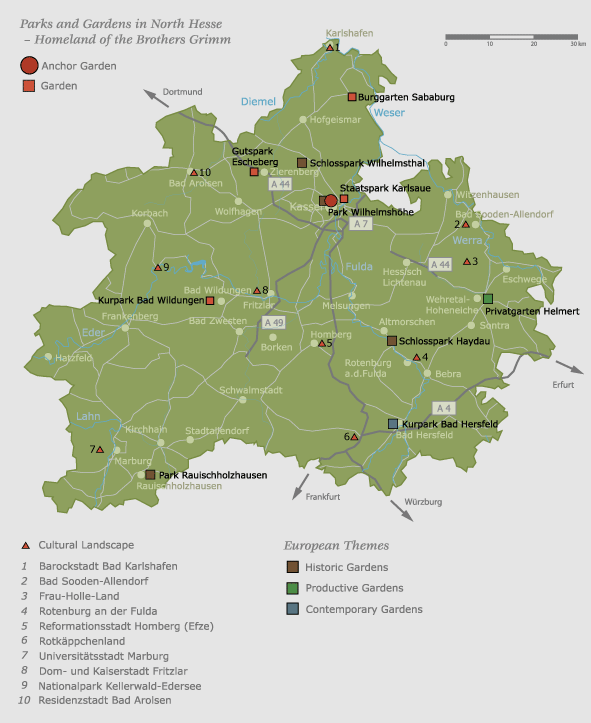 Parks and Gardens in North Hesse – Homeland of the Grimm Brothers
Parks and Gardens in North Hesse – Homeland of the Grimm Brothers
North Hesse is the homeland of Jacob and Wilhelm Grimm, the most popular and best- known Germans worldwide. This is where they spent the longest period of their lives, a particularly fruitful and productive time to which all their major projects are closely linked. Their “Children’s and Household Tales” is the most frequently published collection of stories worldwide and is rightly regarded as the most popular contribution of the German nation to world culture.
Gardens and nature played an important role in the brothers’ lives. Thus, they were fascinated by the splendour of the Wilhelmshöhe and regularly brought visitors to see it, including Annette von Droste-Hülshoff, for example. When they went on journeys they also enthused about the magnificent park in their homeland. They had a sweeping view of the summer residence, including the palace and the statue of Hercules which crowns the cascades, from their house on today’s Brüder-Grimm-Platz in Kassel. The house was one of two pavilions which are part of a gatehouse.
During their years in Kassel, the brothers went walking in the Karlsaue almost every day to relax from their everyday business. They enjoyed the peace and quiet seclusion of the park at the edge of Kassel’s inner city. Numerous anecdotes in letters and diary entries still give us information about this today.
Wilhelm Grimm’s sister-in-law, his wife Dorothea’s sister, lived in Bad Wildungen. Numerous visits to the long-established spa town and periods spent there by the family are thus well-documented. Today, Bad Wildungen and the village of Bergfreiheit focus particularly on Grimms’ fairy tales and the figure of Snow White against the backdrop of old mining traditions.
A contemporary garden can be found in hidden in the woods near Zierenberg. This is the estate park of the von der Malsburg family in Escheberg. Friends and companions of the Grimms as well as other Romantic artists enjoyed the hospitality of Karl Otto von der Malsburg, a patron of the arts. Among these were, for example Emanuel Geibel and Ludwig Emil Grimm, the Grimms’ painter brother.
At the end of the 19th century, the ruined castle of Sababurg at the heart of the mighty Reinhardswald was already commonly regarded as a “place of longing” sprung from one of the Grimms’ fairy tales. The park finally became romanticised as the Sleeping Beauty Castle at the turn of the century and has been regarded as the fairy tale castle of the Grimm brothers for over 100 years now. Today’s visitors to the historical castle garden are welcomed by a monument to the Grimm brothers surrounded by roses.